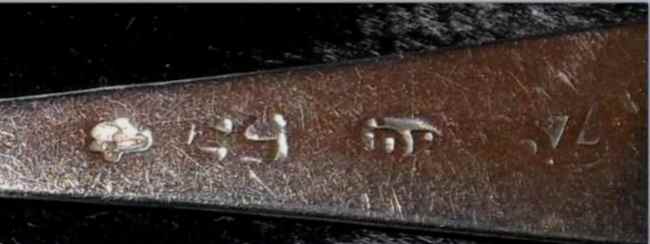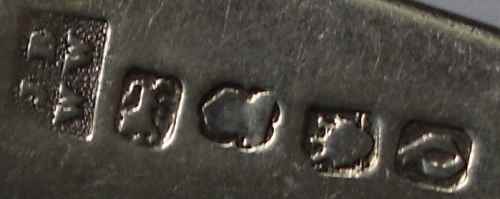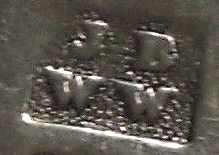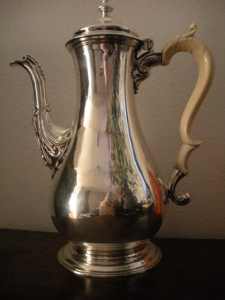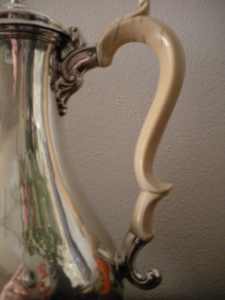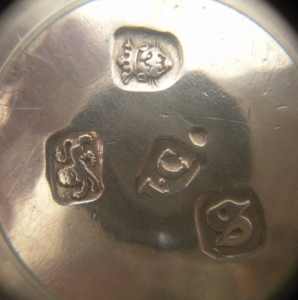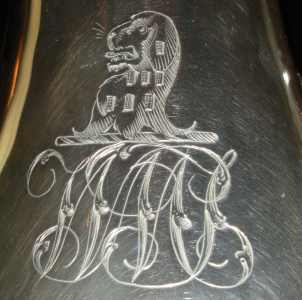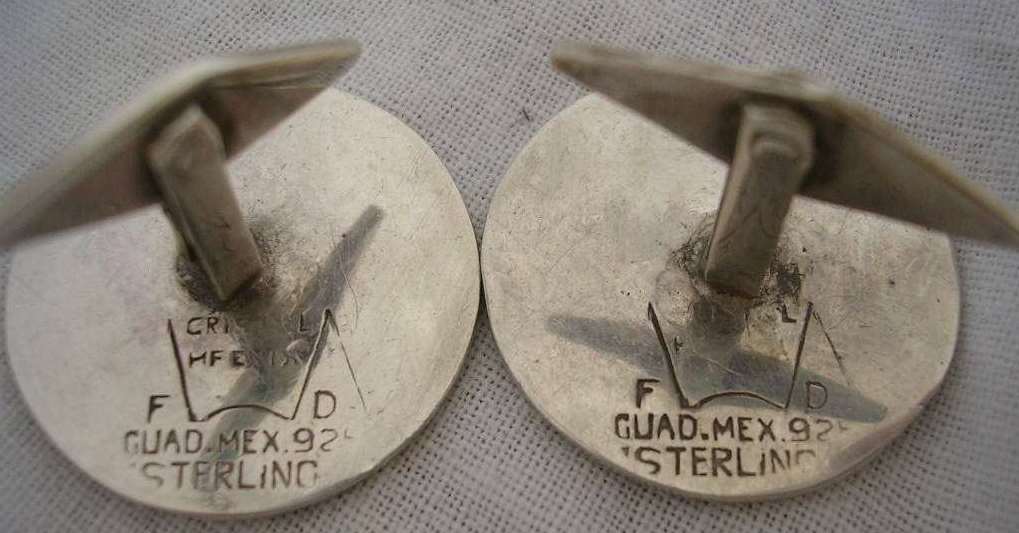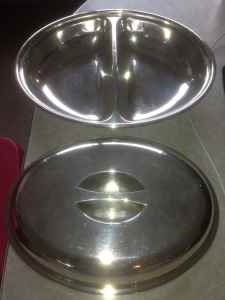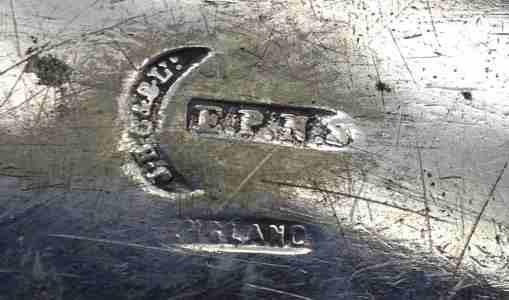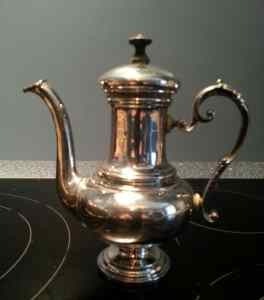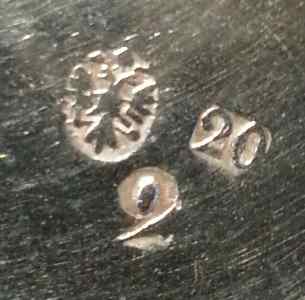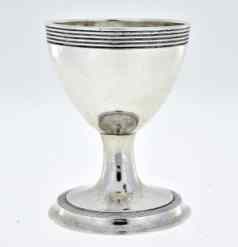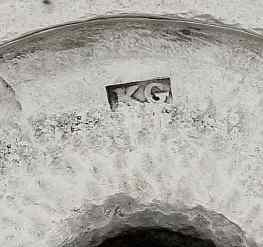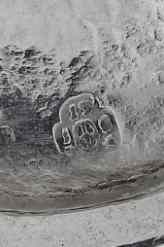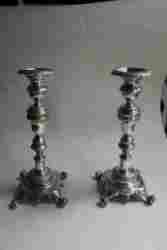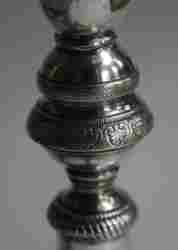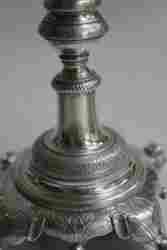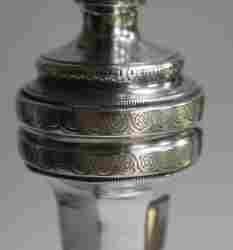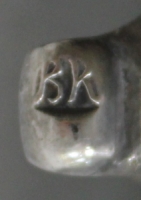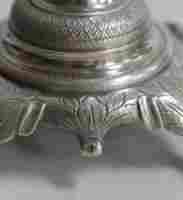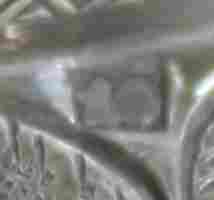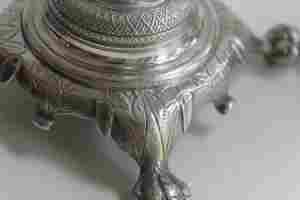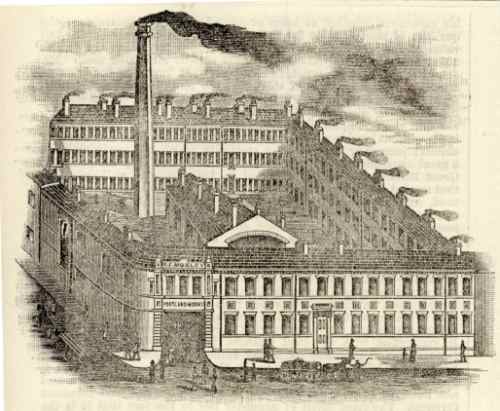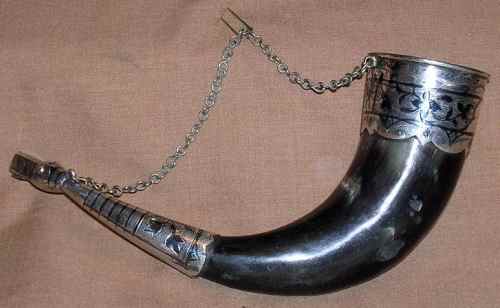
Lazar Freidgeim presents:
Niello Drinking Horns of Kubachi

Kubachi is the village whose name is known far beyond
the borders of Dagestan (Russia). It is located high in
the mountains. The Darghins live there, representatives
of one of indigenous nationalities of Dagestan. During
the middle ages the village was widely known in Dagestan
and abroad as an important metalworking centre, where
coats-of-mail, swords, daggers and the like were
produced.
This village is located very close to the Dagestan's
capital Makhachkala. But it's more than 40 hours by
train from the Russian capital Moscow. Dagestan is a
small part of federal Russia.
The name of the village - Kubachi - represents the
Turkic from the Persian word "Zirihgheran", which means
"makers of weapons". This land was mentioned by some
Arab and Iranian historians and travelers as early as
the 9th and 10th centuries.
Silversmiths manufactured many different elements of
arms and the costumes for warriors such swords, daggers,
guns and cartridge belts, or belts......
click here

|
Welcome to new ASCAS members:
Margott Giroux - USA
Paul Grogan - UK
Coralia Jianu - UK
Mario Maffei - Italy
Julio Paniagua Marini - Italy
Annelise O'Hea - USA
Neale & Nessie Talbot-Scobie - Australia
a name="RONCALLI">Enzo Roncalli writes:
... I need information about this silver coffee pot hallmarked
London 1773.
I'd wish to identify the maker and possibly the crest.
Furthermore, what is the meaning of the little symbol besides
the maker's mark?
Thanks in advance for your help.
Enzo Roncalli
The coffee pot is hallmarked London 1773 and the maker's
mark is ": IC pellet between". In this period three silversmiths
used a similar mark:
John Cormick (from 1760), John Cox (from 1763) and Joseph
Creswell (from 1767). They were still active in 1773 as "smallworker"
but I believe unlikely that a similar coffee pot has been made
by a "smallworker".
Another maker using a similar mark was John Carter II,
registered as "plate worker", but his hallmark was entered three
years later (1776). Nevertheless Grimwade states for John Carter
II "a similar mark found earlier. Not in register" and "there is
evidence that he was supplying candlesticks to the firm of
Parker and Wakelin as early as 1769 (Wakelin, Workman's
Ledger)".
Adding these notes to the "journeyman mark" (you describe it as
"the little symbol besides the maker's mark") it's possible that
the maker of the coffee pot was indeed John Carter II (other
hypothesis or suggestions by ASCAS members will be welcome).
The crest was identified as belonging to various English and
Scottish families as described in the "A crest per Month" column
in bottom page of this newsletter.
Giorgio Busetto
Wladimir Armando Balaic writes:
... , I would like to know if you have any information on this
piece. Manufacturer, year, country.
Wladimir Armando Balaic
Christophe Ginter writes:
... Maybe an ASCAS fellow member would be so kind to tell me who
is the silversmith FD on this Mexican mark
Christophe Ginter
Peter Staniunas writes:
... I found a divided oval side dish by J.B. Chatterly & Sons,
EPNS, Made in England.
I am curious to know if you can identify the time period of
manufacture.
Sincere thanks,
Peter Staniunas
Your piece is marked ENGLAND (not MADE IN ENGLAND): it could
be of early production (c. 1890/1900).
To date silverplate items see my suggestions at
http://www.silvercollection.it/dictionarydecryptingsilverplatemarks.html
Giorgio Busetto
Karin Sixl-Daniell writes
The item appears to be plated to me at first sight,
displaying a c. mid-19th century shape (I would say c 1850-60),
but it would be good to know more about the object. The mark
could point to Franz Schiffer whose excellent workshop does not
appear after 1855, but if these marks pictured are the only ones,
I would not want to assume it is made of solid silver.
Karin Sixl-Daniell
Karin Sixl-Daniell writes
The hallmark looks a bit unusual (it comes across as
stretched on the pictures) and the marks are indeed not easily
identified. The hallmark shows that the item would have been
made between 1800 and 1806/07 which would also correspond with
the design. The maker's mark looks like #1765 and #1766 in
Waltraud Neuwirth's book Wiener Silber 1781-1866, where the
maker is not identified either. However, the other marks on this
page show marks for a Karl Giesswein. The marks' tablet on page
101 of the same book shows a mark for Karl Gieswein entered in
1792. On page 56, a jug made in 1805 by a maker KG is shown,
both marks looking like the ones on the egg cup. Waltraud
Neuwirth's other book Marks of Viennese Gold and Silversmiths
1781-1866 shows a mark for Karl Gieswein on page 136, Viktor
Reitzner's book on Viennese silver ("Alt Wien Lexikon für
Österreichische und Süddeutsche Kunst und Kunstgewerbe")
mentions Karl Giesswein being active from 1792-1805 (page 197).
Maybe his mark was modified a little (corners and not rounded
corners) later on, which would mean that the makers was indeed
Karl Giesswein.
Karin Sixl-Daniell
Ricardo Moreira writes
The pair of candlesticks are of origin Brazilian. The marks "BK" are in reality BR, the mark "10" corresponds the mark "10 dinheiros" that is 833/1000 silver.
The mark "JG" corresponds the silversmith José Ferreira Guimarães (1855-1880) of Rio de Janeiro.
The pair of candlesticks are not sabbath silver but pieces used by the bourgeoisie in tableware and illumination
I hope have helped
Ricardo Moreira
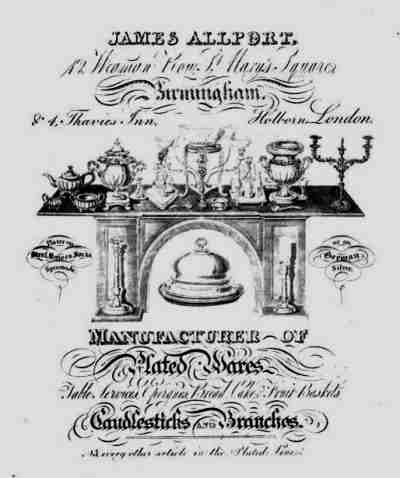
|
This month ASCAS presents an ancient advertisement
of:
JAMES ALLPORT
MANUFACTURER OF
PLATED WARES
Table Services, Epergnes, Bread Cake and Fruits
Baskets
CANDLESTICKS and BRANCHES
The firm was active at 12 Weaman Row, Birmingham and 4
Thavies Inn, Holborn, London
This image is part of the
ADVERTISEMENTS IN SILVER - SILVER ADVERTISING
section of www.silvercollection.it website
|
"A WORD per MONTH"
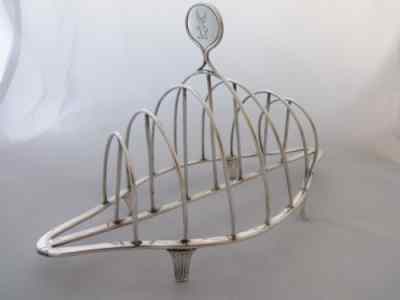
|
TOAST RACK
TOAST TRAY
Toast rack or toast tray is a serving piece having
vertical openwork partitions and a vertical ring for
carrying several slices of toast (usually four to eight).
The slices stand upright in each space, sometimes with a
flat bottomed tray to support them.
Early examples were in the form of a single row of
vertical posts on a wire-ring base but later ones have
circular wire loops to separate the slices......
more
|
"A SILVERSMITH per MONTH"
|
|
ROBERT FEAD MOSLEY
R.F. MOSLEY & CO - R.F. MOSLEY & SON - MOSLEY & CO LTD
Robert Fead Morley was born
into a family of well-known London jewellery and allied
trades manufacturers. Since the early 1800s several
branches of the family were active or had connection
with the jewellery trade around Hatton Garden area of
London.
Robert Fead Mosley (1841 - 1921) was the son of
Cornelius Lewis Morley a "steel pen holder & pencil case
makers & Birmingham & Sheffield factors". He began his
own business in Sheffield and in 1864 when was listed as
"scissor and table knife manufacturer, 214 Brook hill",
moving to Portland Works in Portland Lane just off West
Street in 1871 (Portland Works consisted of small units
used as temporary manufactories for smaller businesses
unable to keep a whole premises)....
more
|
"A CREST per MONTH"
ASELOCK (1), BLADES (2), BLAYDESS (3),
BLAYDESS-MARVEL (4), BOWER (5), BRAYBROOK (6), CLARK
(7), CLIFFORD (8), DESBROWE (9), ELLERKER (10), GEORGES
(11), GRIFFIN (12), HAIGH (13); HALL (14); JEAFFRESON
(15), JEFFERSON (16), KNIGHT (17), KYRELL (18),
LESLIE-MELVILLE (19), M'KILLOP (20), MELVETON (21), MILL
(22(, MORHAM (23), PATTERSON (24), TANNER (25), TAYLOURE
(26), THAYER (27), WILSON (28)
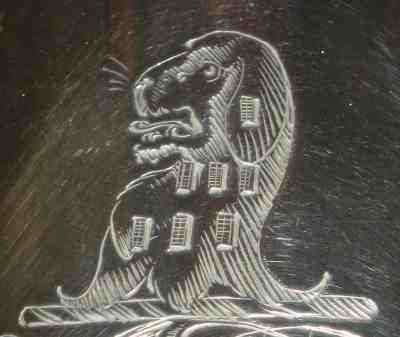 |
A crest used by many English
and Scottish families.
(1) Suff. (2) Yorks. (3) Notts. (4) Yorks. (5) Dors. (6)
Baron (Neville-Griffin) (7) unknown (8) Unknown (9)
unknown (10) Yorks. (11) Glouc. (12) unknown (13) Yorks.
(14) Durh. and Oxon.(15) unknown (16) unknown (17)
unknown (18) Kent (19) Earl of Leven (20) Sco. (21) Sco.
(22) unknown (23) Eng. (24) unknown (25) Somers. (26)
unknown (27) Ess. (28) Sco.
The crest is described as "a talbot's head erased or
guttée" (talbot: a hound with long pendent ears).
The crest was found on a silver coffee pot, hallmarked
London, 1773, silversmith maker John Carter II
(possibly)
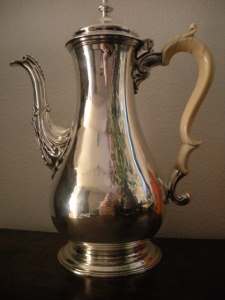
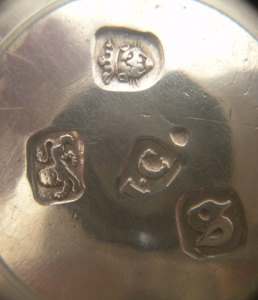 |
Closing our FEBRUARY 2014 edition of
ASCAS Newsletter I hope you have appreciated its content.
Your comments, suggestions and advice will be of great help.
My thanks to
Wladimir Armando Balaic, David Boddy, Lazar Freidgeim,
Christophe Ginter, Enzo Roncalli, Karin Sixl-Daniell, Peter
Staniunas for their precious contributions.
Giorgio Busetto
Secretary
DISCLAIMER AND PRIVACY POLICY
ASCAS is a community of people having a common
interest in antique silver.
It is a non-profit association without commercial links.
Membership is open to whomever has a true interest in
this subject matter.
ASCAS has no real property and no fees are requested nor
accepted from members.
ASCAS keeps in touch with its members only through
periodical newsletters, e-mails and web-site updating
and ignores and is not responsible for any other
activity pursued by its members.
Likewise, ASCAS is not responsible for opinions,
evaluation and images displayed, and in any form
published or supplied for publication, by its members
who, in any case, maintain the property of their works
and assure the respect of national and international
legislation about Intellectual Property.
ASCAS does not have the full addresses of its members (only
town, country and e-mail address are requested for
membership).
ASCAS handles and protects with care its members' e-mail
addresses, will not disclose the addresses to third
parties, will use this information only to reply to
requests received from members and for communications
strictly related to its activity.
These rules are expressly accepted by submitting the
membership request.
|
|
 newsletter
# 117 February 2014
newsletter
# 117 February 2014











